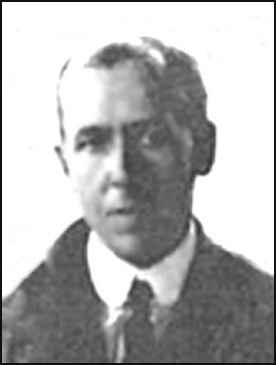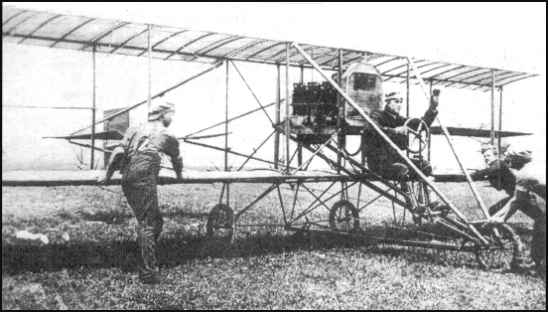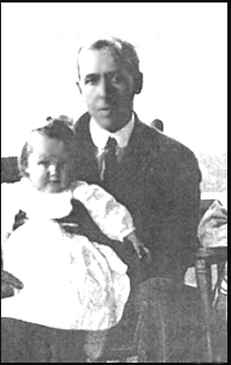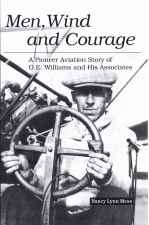
1872-1917 AKA O. E. Williams |
 |
Collection of Cyndi Korsgaard, 4-3-07 Great Grandaughter of O. E. Williams |
 |
The aviator is Elling O. Weeks. Photo and legend from Cyndi Korsgaard, 4-3-07 |
|
via email from Nancy Mess, 1-18-06 Niece of O. E Williams By Fall 1913 Williams built an advanced tractor biplane as well as participating in the THE NEW YORK TIMES's Aerial Derby, the feature of Oakwood Heights Aeronautical Society meet on Staten Island to commemorate the first flight of the late Wilbur Wright in a power driven aeroplane. Late 1914 Williams moved his school, exhibitions, sales and manufacturing to Fenton, Michigan, approx. 60 miles from his birthplace of Dexter, Michigan. While in Michigan, Williams's ambition grew stronger and so did his endeavors. His school grew significantly with his licensed pilots contracted with the Patterson Aviators, of Detroit, offering patriotic exhibitions throughout a larger portion of the US for 1915 and 1916. (Many of those flights are recorded in the first airplane airmails history of the US). Late in 1916, Williams was seeking a southern location to enable his efforts to continue throughout the year. He chose a 53-acre farm near Mobile, Alabama to start another school and manufacturing facility. Williams, his wife Inez, along with two of their children, Ralph and Sarah, established their southern aviation location. By Spring 1917 Williams resumed recruitment of new students and continued his exhibitions. He had secured a contract with the US government to build 12 of the Williams aeroplanes with manufacturing to commence on Nov 1. On Oct 25, 1917. Williams experienced a fatality during his descent when his aircraft struck an anthill. Osbert E. Williams contributed much to the early progress of American aviation history. Starting at a more advanced age than most of the birdmen of that era, he practically taught himself to fly on self-built aircraft devised by trial and error. Considered a safe, careful aviator, he had few accidents until the serious one that cost him his life. He taught a number of students to fly, many of whom went on to noteworthy flying careers, including four who became officers in WWI. 1930, OCT 27 American Aero Philatelic Digest and Canadian Stamp Journal; Vol. 1, No. 3, p.1 and 8. The Fenton Michigan Memorial. The CHAMBER OF COMMERCE of Fenton, Michigan arranged the commemorative of twelve men (listed below) who gave their lives in the development of aeronautics. A cachet was arranged showing the names of those men. Letters arrived from all parts of the world to be mailed with the special cachet applied. 5,300 letters went into the mail on that Memorial Day, 1929. "TO THE STUDENTS OF THE WILLIAMS SCHOOL OF AVIATION AND OTHERS OF OUR YOUNG MEN WHO GAVE THEIR LIVES IN THE DEVELOPMENT OF AVIATION" O. E. Williams Al Boshek Ransom Fowler Don McGee Harold Bruner Leroy Wilson Lt. Cyrus Bettis (served in WW1) Lt. John Burns (served in WW1) Capt. E. G. Knapp (served in WW1) Lt. J. Thad Johnson (served in WW1) Sid Robberts |
|
by Vera Hogan, Staff Reporter |
 |
|
With a "wing and a prayer," members of the Osbert E. Williams Flying School in Fenton help a fellow student prepare for take-off.
Several bicycle parts and baling wire were used to keep these early planes together. TRI-COUNTY TIMES - SPECIAL SECTION SUNDAY, AUGUST 9, 1998 - PAGE 7 |
|
During the early 1900s, more than 1,000 automakers, big and small, were out to prove their
version of the "horseless carriage" was the only way to travel. Then there were those who dreamed of flight. Daredevils they could be called, with a desire so strong to fly high above the rest, that safety was perhaps too low a priority. Fenton had its share of young men who sacrificed theri lives in the name of aviation. In 1914, a stranger named O.E. Williams arrived in Fenton. He was a barnstormer, having earned the title of aviator performing stunts at state and county fairs. According to a former Fenton historian, Williams first came to Fenton to repair a hydroplane for a wealthy Flint sportsman who had a summer cottage at Long Lake (Lake Fenton). Williams liked it in Fenton and decided to stay. He soon attracted a group of young men who shared his passion for flight and believed there was a future in aviation. He found a vacant building on LeRoy Street , just south of the present community center. At this location, Williams started the O.E. Williams Aeroplane Co., where he and a group of boys began assembling what they coined "aeroplanes." A flat pice of land at the north end of Lake Fenton was used as a landing strip. It wasn't too long before the young men decided they would like to fly the new contraption on their own, and the Williams School of Aviaiton was formed. Construction of the early aeroplanes were considered somewhat flimsy. There was no elaborate fuselage and the motor had a bad habit of conking out during flight. Much like a model airplane of today, the propeller was made of pieces of wood that were glued and pressed together. Hay wire was often used to secure and strengthen the strut connections. The fact that these contraptions made it off the ground and sometimes remained airborne, despite the techniques used to build them, was a marvel to the young would-be aviators. Word of the Williams school and the aeroplane reached beyond the local borders, causing young boys from other cities to leave home to seek their wings in Fenton. According to an October 1930 issue of the American Aero Philatelic Digest, young fellows, whose middle names were "Dare," mastered the art of stunt flying and were ready to put this mastery to a test. "Passengers were taken up to be thrilled," according to the Digest. "If the frame made too much noise on account of being too loose or broken, it was brought down and a piece of wire found, wrapped around the faulty part and the flight was completed." About a dozen young men eventually left Fenton to display their flying talents elsewhere. Over the next several years, all of them, including Williams, lost their lives doing what they loved most. In April 1928, the last of Fenton's air school pilots, E.G. Knapp, fell to his death in Texas. The Associated Press reported, "Last of Fenton Air School --Knapp's Death Takes Last of Fenton Fliers who Sacrificed Lives for Aviation |
 |
Williams and one of his daughters Collection of Cyndi Korsgaard, 4-3-07 Great Grandaughter of O. E. Williams |
via email from Cyndi Korsgaard, 4-3-07 I would love to email more and even talk. I also have a genuine stock certificate from his aeroplane company. My father gave each of us 4 kids a framed certificate for Christmas a few years ago. I can scan and email if you would like to see it. Please, reply to this email, there is so much I want to learn and teach. Thank you, Cyndi Korsgaard |
|
|
|
1911: O E Williams Aeroplane Co. (fdrs: Osbert Edwin & Inez Williams), Scranton PA. 1912: Flying field at Forty Fort PA. 1914: Williams School of Aviation, Fenton MI. March 1917: Sold local operations to Flint Aircraft Co, Flint MI, and moved to Mobile AL, where a new flight school was established. For the rest of the story, including information on six of his planes, click on the title above. You may want to use the Find function on "Osbert"to find the right "Williams." |
 |
Men, Wind and Courage A Pioneer Aviation story of O.E. Williams and His Associates Nancy Lynn Mess Product Details Paper: 406 pages; 230 B & W images Size: 6" x 9" x .93" Publisher: William Martin Press ISBN: 9780615309019 |
|
Description: MEN, WIND and COURAGE, A Pioneer Aviation Story of O. E. Williams and His Associates,” by Nancy Lynn Mess. Soon to be released, MEN, WIND and COURAGE, presents the characteristic spirit and accomplishments experienced by a number of pioneer aviators for man’s newest invention the aeroplane. Amongst them was O.E. Williams, whose pioneer contributions to the science of aviation are unknown today. Mr. Williams, a highly ambitious man, with his progressive efforts and strong enthusiasm, along with others like him are what transformed aviation from its infancy into its advanced science of today. The career of O.E. Williams is revealed along with those who were affected by his passion for aviation. Mr. Williams, a talented engineer who changed his vocation to focus on aviation, was a strong advocate for safety with innovative results. Williams’s activities took place at Scranton, Pennsylvania; Fenton, Michigan; and Mobile, Alabama. MEN, WIND and COURAGE offers many photos and text of the various Williams aircraft, flight schools, manufacturing facilities, hangars, flight-speedometer, patents, and the personal side of this remarkable man. Mr. Williams was the stellar attraction of the Patterson Aviators who were in popular demand throughout the midwestern states and lower Canada. To appeal to many interests this book focuses on description for events and experiences rather than technicalities. Many of the men lived beyond Mr. Williams’s lifetime. Elwood J. Junkin and Clayton J. Brukner evolved the WACO airplanes. A number of exclusive interior photos are presented of the WACO factory. Lt. Cyrus Bettis established many military aviation firsts. Others, such as Russell B. North, never lost the passion for aviation. And contracted pilots Elling O. Weeks, C. Ray Benedict, and Al Boshek all had their trials and tribulations with their exhibition flights in the Williams Aeroplanes. Those featured are: Advance Aircraft Co. ROBERT T. ARMSTRONG AL BOSHEK LINCOLN BEACHEY BERT BEAVERS C. RAY BENEDICT CYRUS BETTIS CLAYTON J. BRUKNER HAROLD BRUNER JOHN BURNS Burns Flyers TONY CASTELLANE RUSSELL CLARK JOHN COOK ANTHONY DAUNER WALTER H. DAVIDSON First Aero Squadron ED DAVIDSON Fenton Airways Fenton Historical Society A. F. FERGESON RANSON FOWLER FRANK FREEMAN GEORGE M. FRENCH MARTIN GAIRENS-McCORMICK JOHN GUY WALTER HENDERSON ANTHONY “Tony” HOESEL WALLACE HOSP J. THAD JOHNSON ELWOOD JUNKIN EDGAR L. KEULING E.G. KNAPP BOYD LAMBERTSON FRANK LAMBERTSON LUKE LEROY “Roy” LATSHAW EARL B. LOPP DON McGEE DAN McGUIRE ROBERT MEYERS ART MOLINE NEW YORK TIMES Aerial Derby ALFRED F. NORENBERG RUSSELL B. NORTH FRANK PAINE DEXTER PARKER Alderman RAY PARKER JOHN T. PATTERSON Patterson Aviators W. E. PRICE SID (Alphonso, Miron, Myron) ROBBERTS S.D. ROBINSON WACO Waco Aircraft Company REYBURN WATRES ELLING O. WEEKS JAY WHITLEY GEORGE WHITNEY OSBERT E. and INEZ WILLIAMS Williams Aeroplane Company and School SAMUEL GEORGE “BABE” WILLMERT LEROY “Roy” WILSON ED WISSMILLER JOHN WYMAN Although every effort is made to provide accurate information in this publication, we would appreciate readers calling our attention to any errors by writing us at: Nancy Mess, author William Martin Press P.O. Box 3984 Ithaca, NY 14852-3984 |
|
Knoxville Journal and Tribune Knoxville, Tennessee: October 26, 1917 Transcribed by Bob Davis - 4-5-07 Williams, who was about 45 years old, had been making exhibition flights here. He was not connected with any branch of the government flying service. He was a native of Ann Harbor, Mich., but previous to coming here had been residing at Scranton, Pa. |
|
If you have any information on this Early Flier, please contact me. E-mail to Ralph Cooper Back 

|